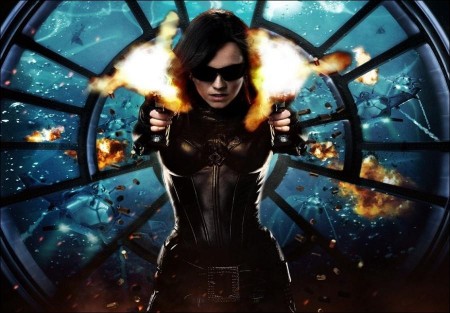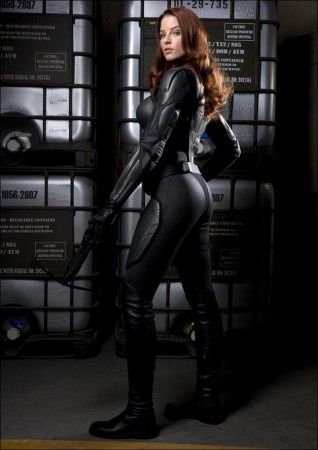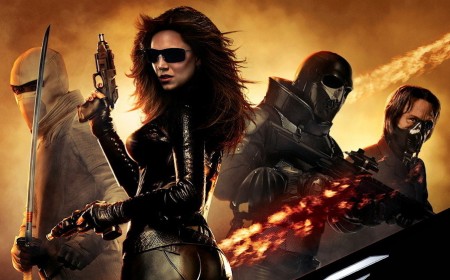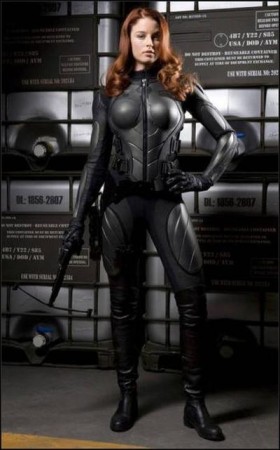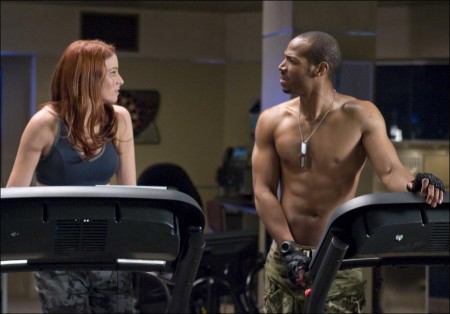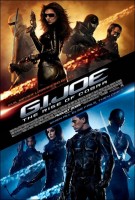The popularity of G.I. Joe persisted through the Vietnam War era and beyond, introducing new gadgets, but it was in 1983 that G.I. Joe went through its biggest change. That year, he went from being a 12” figure to the, by then, more common 3 ¾” figure kids had already started collecting in other series. G.I. Joe also went from a “he” to a “they” – a team of super-elite soldiers from around the world, each with his/her own specialty and state-of-the-art gear to help them do their jobs.
In “G.I. Joe: The Rise of Cobra,” there’s Ripcord, an expert marksman and weapons specialist; Snake Eyes, a ninja warrior armed with Katana swords and a Glock pistol, skilled in martial arts, reconnaissance and infiltration; Scarlett tough and bright, also a martial arts master and skilled with a gas-propelled Crossbow Pistol; Breaker, a specialist in deciphering covert electronics and technology; Heavy Duty, the team’s weapons specialist; General Hawk, who is the team’s commander; Courtney “Cover Girl” Kreiger, a runway model-turned-spy and General Hawk’s assistant; and, of course, Duke, a combat veteran with courage to spare: he’s the G.I. Joes’ leader and soldier personified.
“Each one has a particular skill they’re really good at, and the team counts on that skill,” says di Bonaventura.
While a hugely-popular animated TV series debuted in 1985, it was a long-running series of comic books that truly helped retool G.I. Joe and give it its engaging mythology. The combination of new action figures, comic books and a TV show, helped propel G.I. Joe farther than it had ever been. “They ignited the collective minds of the fans of that era,” says Goldner. “In fact, the G.I. Joe of the 1980s was more successful, globally, than the original.”
From Action Figure To Action Heroes
For the comic book, Hasbro made the choice in partnering with Marvel Comics. A young editor named Larry Hama was assigned the task of creating a comic book series for G.I. Joe from the ground up. At the time, says Hama, all that existed were designs for the figures, but no story. “We went to a meeting and they said, `Well, we have these ten figures,’ and that’s what they had,” he recalls. “They had drawings of what the figures were supposed to look like. There was a guy with a rifle and it said, `Infantry,’ and there was a girl with a crossbow, and it said, `Intelligence.’ We said, `Well, where’s the rest of it?’ and they said, `Well, this is what we have.’”
The story also was going to be clearly one-sided. “We asked them, `Well, what are they going to do, just march? There has to be some sort of conflict.’ So we decided for the comic book, we’ll have these guys called Cobra who will be the bad guys. We told them, `We’ll take it from here.’”
Though Hama considered himself “a duck man” (as opposed to a superhero guy) at the company, he begrudgingly took on the assignment, figuring the series would last no longer than a few years at best. “Common knowledge at the time was that a toy book never lasted more than three years.” Educating himself with materials collected from military bookstores and other sources, he eventually created dossiers for each character in order to keep them straight in his own mind, as well as the fans’. Those dossiers made their way onto the backs of the toys’ packaging, helping to clearly define the characters that would stay fixed in G.I. Joe lore.
Spanning 155 issues, Hama’s comic books, says Goldner, “told this amazing story of a G.I. Joe team up against these Cobra forces. For a whole generation, this complete fantasy was a real phenomenon.”
The Gathering Forces
With decades of success and a far-reaching fan base, it seemed only natural that G.I. Joe would make its way to the big screen. So what took so long? “Hasbro had looked at it in the past and talked to many different filmmakers,” explains Brian Goldner. “”I just don’t think the company had a sense for how to tell the story, keeping the mythology intact, and help filmmakers see what’s possible in a G.I. Joe versus Cobra story.”
In 2000, the company began to take a new look at ways to reinvent its brands, including G.I. Joe. “We’d been strong in the boys business. We have Transformers, we have G.I. Joe. So we started to focus in on what kinds of stories we tell that matter today,” notes Goldner.
Power-hitting Hollywood producer Lorenzo di Bonaventura and his production company, di Bonaventura Pictures, had a strong interest in the idea of a G.I. Joe film and began to pursue the project with Hasbro. “Lorenzo met with Brian Goldner, and they talked about making G.I. Joe into a big feature film,” notes executive producer Erik Howsam. Howsam himself was a G.I. Joe kid from the start. “From four years old, I grew up with not only the 12-inch G.I. Joe, but also when I was 11 years old, the reinvented G.I. Joe of the `80s. I’d race home from school, watch the cartoons, buy the comic books, buy all the toys. So when Lorenzo said, `One of the things I’m working on is G.I. Joe,’ my eyes just lit up.”
Although Paramount bought the rights to G.I. Joe first, it was di Bonaventura’s success with another Hasbro property, the 2007 blockbuster Transformers, that finally got the project off the ground. Transformers was actually the second thing we got involved with,” he recalls. “The attitude of this G.I. Joe comic book was just something a lot of people couldn’t get their heads around completely.” The enormous success of Transformers changed all that. “It was quickly apparent to everybody the kind of success you can accomplish with this kind of deep-seated mythology. Then it was, like, `Oh, I see, I see. I got it. Reality and fantasy mix really well together.’ That’s what got `G.I. Joe’ going and Paramount has been an unbelievably supportive studio to work with in it.” Adds executive producer David Womark, “Lorenzo’s the type of guy that once he decides he’s making a movie, it can be a year, it could be ten years, but the movie gets made.”
To helm such a story of both super-action and mythology, di Bonaventura approached a man who has practically recast the mold for both genres: Stephen Sommers. His deft handling of the myriad elements in the non-stop action films “The Mummy” and “The Mummy Returns,” from action-heavy set pieces, to globetrotting adventure, self-effacing humor, larger-than-life characterizations and sparring romance in between life-and-death situations, turned both films into worldwide box office gold.
“I knew all his work through `The Mummy’ series,” says Goldner. “That’s a terrific combination of the thread of mythology, but taken to a whole different place with a great action-adventure feel.” Adds di Bonaventura, “Steve is fun, energetic, and he’s passionate about it.”
The film posed a unique challenge to the director. “What sparked my interest was the notion that this would be a cross between a comic book and a James Bond film,” he says. “The idea was that we could have this giant canvas with larger-than-life characters and a great mythology that already existed in the G.I. Joe world.” What made the premise unique for Sommers was the inclusion of that mythology. “Steve absolutely understood the world of the original 12-inch G.I. Joe but, as he began to understand the G.I. Joe vs. Cobra story, he got very excited, and that really helped propel the movie,” says Goldner.
“The G.I. Joe I grew up with is a very different thing from this movie,” Sommers says. “The reinvention and reinvigoration that Hasbro did in the `80s basically rebooted the whole concept, and they supported it with this rich mythology from the comic books and the animated series. We felt that it was just filled with great potential for a motion picture.”
Bringing the G.I. Joe story to life meant more than just replacing an action figure with real humans. “While we’re respectful of the original 12-inch G.I. Joe, this movie is not a toy movie,” says di Bonaventura. “It’s really based on the comic book series from the `80s that comes with an intricate mythology and a whole group of fully fleshed-out characters.”
To help those characters fill their battle suits, di Bonaventura turned first to screenwriter Michael B. Gordon, who co-wrote the story with Stephen Sommers. Later, screenwriters David Elliot & Paul Lovett were brought in. The duo had previously collaborated on the hit action thriller “Four Brothers” starring Mark Wahlberg. Then the filmmakers turned to Stuart Beattie, whose success in the “Pirates of the Caribbean” trilogy made him uniquely qualified to breathe life into these cultural icons.
Says Beattie: “Lorenzo just called me, out of the blue, and said, `Hey, let’s do G.I. Joe.’ I said, `Yes,’ one reason being because of Lorenzo. He knows how to pull the trigger and get people moving around him. I knew it would get made. I’m from Australia and I didn’t really grow up with G.I. Joe, so when I was introduced I just found it an irresistible world.”
“A lot of people spent a lot of time in their childhoods and also in their adulthoods with these characters,” says Sommers. “We have a certain responsibility to execute that. We’d hate to disappoint somebody who’s invested 20 or 30 years in G.I. Joe.”
Arnold Vosloo, veteran actor from Sommers’ “Mummy” films and who plays ZARTAN in G.I. Joe, knows this firsthand. “Whenever you do something that has a following, it’s always tough because you don’t want to let the fans down. If you screw it up, they’ll stop you in the street and tell you.” Adds Marlon Wayans, who plays RIPCORD, “If we do this wrong, there’s gonna be some crazy comic book guy at my house dressed in a G. I. JOE costume trying to kick my ass!” he laughs. “But, I think they’ll be happy with how it turned out.”
For a film to be a success, it has to appeal not only to hardcore fans who have been champing at the bit for decades to see their heroes come alive, but also to potential new fans who are simply out for a great ride. “In a sense, as filmmakers, we have to serve two masters,” says executive producer David Womark. “We have to satisfy the hardcore fans, but we also want the film to have broad appeal for people that don’t know anything about G.I. Joe.”
Stephen Sommers is someone who is particularly adept at accomplishing that difficult balancing act, Womark notes. “That’s one of the aspects of the film that Stephen really got into in a big way, walking the fine line between doing something that honors the fans but, at the same time, had a component of modern adventure and excitement like a lot of his movies do.” Adds Howsam, “That’s something I think Stephen understands in a big way and it was a real priority for him.”
Sommers has a true understanding of how to manage the story to respect both audiences, he says. “I feel we’ve taken the best of these colorful personalities. We’ve been respectful, but in no way did we handle them with kid gloves,” he explains. “What fills a comic book page or a small screen won’t necessarily fill a movie screen, so we have painted with both fine and broad strokes. In some cases, we’ve even given them much more detail and back story than was presented in the books and the series.”
Beattie also studied both military terminology and true G.I. Joe slang. “There are certain phrases that these characters use which quickly identify them to fans as JOE characters,” says Beattie. “This is not just a military film, it’s a G.I. Joe film.”
Beattie’s initial research finally paid off when he got the call to “re-engage.” “It was good that I already knew G.I. Joe so well because there would have been no time to get up to speed on it. I just had to get in there and write.”
All the writers on “G.I. Joe: The Rise of Cobra,” were careful to follow the basic G.I. Joe story template that fans have come to know and love: the G.I. Joe team has a secret weapon they’re transporting and must keep it from falling into the wrong hands.
However, the screenwriter’s knowledge of the G.I. Joe world helped keep the story unique. Beattie understood the team’s secret nanotechnology weapons -microscopic robotic devices. “We wanted something that could only exist in the world of G.I. Joe and not in any other,” notes Beattie. “It’s the fans who have made G.I. Joe what it is, so whenever you take on a project like this, you’ve got to listen to them and understand what it is that they want, and the only way to do that is by becoming a fan yourself.”
A cast this size is a clear indicator of the sheer magnitude of “G.I. Joe: The Rise of Cobra.” Stephen Sommers’ films are typically bursting at the seams, but “JOE” represented a formidable project for even the heartiest of production teams. Over an 82-day shoot, the crew worked 160-plus sets and set pieces that were designed and built on stages in the L.A. suburb of Downey and other locations throughout the city as well as on location and on stages in Prague.
In all, 25 different locations were scouted, designed, built, dressed and shot. That included an around-the-world trip of location shooting any traveler would envy – France, Norway, the Czech Republic and North America. Paris provided the iconic landmarks, while Prague offered streets with slightly fewer challenges for a production seeking to film a high-speed chase through the French city. The chilly climes of Norway mimicked the North Pole. A Fort Worth, Texas armed forces base and Downey’s former aerospace-facility-turned-film-studio (that was once home to the Space Shuttle) provided ample military locations.
It wasn’t enough that Sommers and his filmmaking team were bringing one of the most-loved comic-and-action figures to life, they did so under an absurdly compressed timetable. While such action-heavy fantasy films typically have anywhere from 24 to 30 weeks to prep production, “G.I. Joe” had a total of 12 weeks of prep, allowing the production to begin filming immediately after the end of the WGA strike in Los Angeles in February 2008.
“Every department was so crazed, every single department was trying to get everything up to speed and they really did amazingly,” says producer Bob Ducsay.
“Prep on a movie like this would normally be six, seven, eight months. We did it in three.” It wasn’t just a matter of building sets and finding locations. “This is a manufacture movie,” comments co-producer and unit production manager JoAnn Perritano. “That means we’re making the props; we’re making the costumes. It’s not like we can just go and buy stuff off the racks. Every actor had to be body-scanned to make specifically unique costumes built just for them.”
All the more impressive is the fact that the production finished two days ahead of schedule. “That’s positively remarkable,” declares executive producer David Womark. “That shortened prep time wasn’t enough time to do a movie half this size. A lot of that is a testament to Stephen’s creative decisiveness. He really had a good handle on the story and the characters and, logistically, we came up with a good plan that helped him along.”
The tight schedule created a pressurized environment for the production. “It made everything really crazy. We were making decisions so fast, one on top of the other. It was like a pressure cooker. It made everybody stay on top of their game.
Sommers and his producers procured the finest in behind-the-scenes talent to meet the many time-and-craft challenges “G.I. Joe” posed, including producer/editor Bob Ducsay, executive producers David Womark, Gary Barber, Roger Birnbaum and Erik Howsam; cinematographer Mitchell Amundsen, whose work on Transformers gave him a unique understanding of the subject material; production designer Ed Verreaux; editor Jim May; costume designer Ellen Mirojnick; special effects supervisor Daniel Sudick, whose “explosive” resume looks like a Who’s Who of the biggest action pictures of the last decade; second-unit director Greg Michael; stunt coordinator R.A. Rondell; and visual effects supervisor Boyd Shermis, along with a veritable platoon of other film craftsmen at the top of their fields.
Bob Ducsay and Greg Michael hold unique positions on the team, having known and worked with Sommers since his earliest days in film. “We started our careers together, so it’s just amazing to be out here doing it again,” says Ducsay. The two met while Ducsay was a teaching assistant in the sound department at the USC Film School. He has since edited all Sommers’ films.
Greg Michael came upon Sommers quite by accident. “The first time I met Steve, he was painting my fraternity house,” Michael recalls. “Steve said, `I just moved here from Minnesota and I’m just earning a living right now so I can go to film school.’ He had been traveling Europe as a busker, playing instruments on the street for money, managing bands, and he had just gotten accepted into film school.”
Michael ended up working as a cameraman on one of Sommers’ student films and they have been together ever since. “Every once in a while, Steve and I will be on the telephone, and one of us will say, `Can you believe this? Here we are in Prague,’ or `Here we are in Bombay.’ It’s been an incredible ride.”
Sommers has indeed come quite a long way since his days painting frat houses, running an explosive roller coaster like “G.I. Joe” in a manner that not only kept the cast and crew on track under incredible duress, but smiling while doing it.
“What I love about Stephen is his excitement,” notes Marlon Wayans. “I think he goes home and holds a G.I. Joe when he goes to sleep every night.” Says David Womark, “He’s the most passionate person on the set and his enthusiasm is contagious.” Greg Michael agrees. “He’s like an electric generator. He excites everybody around him.”
Many liken Sommers’ enthusiasm to that of an 11-year-old boy. “He’s like a kid with an erector set, a multi-million dollar erector set,” says Channing Tatum. Or as Joseph Gordon-Levitt notes, “If you talk to guys my age about playing with G.I. Joe, their eyes light up. `I’m gonna set him up this way, and I’m gonna build this other thing, and I’m gonna attach my guy to a balloon and watch him fly away or pull his head off and put on another one.’ Watching Stephen Sommers direct this movie, you get that same feeling.”
Sommers’ childlike excitement in no way diminishes his creative instincts. “He’s always open to new ideas,” says Stuart Beattie. “Nothing is ever too crazy.” The director’s respect for the crew, in any situation, is enough to draw them back, no matter how difficult the project. “When the phone rang, I couldn’t wait to sign up for a second go around with him,” says JoAnn Perritano, a veteran of “Van Helsing.”
Recalls Rachel Nichols, “He’s very easy to be around. And he’s very savvy. He shoots extremely fast. Stephen knows what he needs, so you don’t spend a lot of time shooting a million different angles of things that you’re not going to use. He’s very concise and that’s why we’re not shooting 20-hour days.”
Sommers-Size
Stephen Sommers has quickly become a master of the action epic, as is evident in his popular “Mummy” movies and “Van Helsing.” To his crew, many of whom have worked with him on all his major projects, his vision for epic scope, and painstaking detail in his propulsive action set pieces, has come to be known as Sommers-sized. It is not merely large-scale for the sake of it, but part of his passion to continually keep the audience’s adrenaline pumping and their eyes glued to the screen.
Sommers builds sequences through careful progression, brick upon brick, with an acceleration that is carefully planned and timed. That includes the overall look of his film, which he entrusted to his production designer Ed Verreaux. “Ed is highly familiar with the world of action and effects movies,” says David Womark, referring to Verreaux’s work on “X-Men: The Last Stand,” “Rush Hour 3” and “Jurassic Park III.”
The unique challenge Verreaux faced had its roots in a franchise that already had an established look, one which fans were familiar with. “One of the things we wanted to do though,” he says, “was try to push it to the next level, while still staying true to the real character of G.I. Joe.”
Having only a passing familiarity with the franchise, Verreaux immersed himself in the world of G.I. Joe. “I went online and went out and bought about $200 worth of G.I. Joe comic books and learned all about DUKE, Snake Eyes and their whole universe. It was kind of fun for me to spend a week reading comic books, just to get a sense of what the world of G.I. Joe was all about.” Notes executive producer Howsam, “Ed really did his homework on the property and created this really vibrant place that the actors, Stephen and everyone could live in.”
The designer not only had to create the contemporary world, but also the unique worlds of both the G.I. Joe team and MARS, and he quickly gained an understanding of how they differed. “In the first big meeting we had with Hasbro, they explained that MARS really had all the slick design stuff, while the G.I. Joe side is a little more utilitarian, closer to everyday military, not quite so over-designed,” he explains.
“I’ve been involved in a lot of big movies,” says di Bonaventura, “but this is one of the biggest movies I’ve ever seen. The scale is enormous and the architecture of it is very specific and has to be exceedingly specific, because you need to be able to differentiate where we are at all times, be it in the world of the G.I. Joe team, MARS or our own world. That was a big demand to place on Ed and his team.”
The crew took advantage of front-end time made available in the compressed schedule, building large numbers of sets during the first portion of production time. “The first couple of weeks we were doing local locations in Los Angeles, partly because we had to have time to get the sets built,” Verreaux explains. During the film’s full-speed-ahead prep and shoot, more sets were continuously built at a single time than on any other film made to date. On average, large genre films usually build no more than 12 to 14 sets during a single period. The “G.I. Joe” production had 168 sets and set pieces constructed for the film.
Many of the largest sets were constructed at The Downey Stages. “There were very few nooks and crannies in the Downey studio that we didn’t in some way or other use or build a set on,” says Verreaux. Among the sets built were the mammoth Urban Combat Level (part of the giant “Pit,” the underground home base of G.I. Joe), the MARS Docking Bay, the G.I. Joe Submarine, the MARS Missile Tube and Launch Tube and the MARS Flight Control set, among others.
The Pit, in fact, is the most impressive, featuring several levels (augmented by several more with visual effects set extensions). “There’s the Urban Combat Level, the Undersea Warfare Level, the Command Center, a myriad of hallways, a medical bay, a rec room, where the G.I. Joe team hangs out and where we get to know them a little better,” Verreaux explains.
“It’s absolutely gigantic,” observes Sommers, “complete with an immense elevator that can transport aircraft to the surface.”
“The amazing thing,” says Sienna Miller, “is that everything works. If there’s a button on the wall that has lights where there should be lights, if you push it, it’ll start flashing.” Co-star Rachel Nichols agrees. “The attention to detail and the authenticity makes the movie come alive for those long-time fans.”
Set decoration was as important a part of art direction for “G.I. Joe: The Rise of Cobra” as for any film. “Our set decorators, Kate Sullivan and Jille Azis, really filled in all of the details,” Verreaux explains. “For instance, when you opened a drawer at the home of The BARONESS and they even went so far as to design the family crest. There was stationery on the table with the family crest and the address with all of it in French. It’s those little touches that you may not see in the film, but it really helped the actors. It helped set the mood for them even though it may not necessarily all be seen on camera.”
Another part of Verreaux’s domain was the fantastic number of aircraft and other vehicles seen in the film. “They’re a whole combination of technology, vehicles and armament that you would hope to see in a `G.I. Joe’ movie,” says Hasbro’s Brian Goldner.
“We basically built all of the military vehicles,” says Verreaux. Multiple versions of each had to be constructed, for cases in which a vehicle is seen in regular operation, then another for special effects rigging, etc., all based on pre-visualization during the film’s prep. “We knew there were going to be `X’ amount of shots of a certain vehicle doing something a certain way. Some had to explode a certain way, some had to flip.”
The crafts are an exciting component for fans who have played with or known the vehicles by name since their childhoods. “Just the sheer number of aircraft, vehicles and underwater craft we’ve managed to stuff into this movie is unbelievable. It’s Stephen’s imagination run wild,” says David Womark. “There’s the Howler, which is a modified G.I. Joe troop carrier, the MARS Razor, a next-generation jet that the MARS have manufactured. Then there’s the Mantis Attack Craft and the Shark Attack Vehicle, which are our underwater mini-submarines. All these vehicles were designed from scratch, specifically for this movie.”
The vehicles, the film’s settings, props and costumes, have one thing in common. “We set the story a decade ahead, which gave us the license to exploit today’s technological advances,” states Sommers. “We’re taking technology that exists in one form or another and positing where it could possibly go. We’re referring to it as `science fact’ as opposed to `science fiction.’”
Each of the technologies shown are “things that we all know the military are doing, we just haven’t seen them yet,” says Goldner.
They’re all things we might one day see on the battlefield, just not now. “They’re what we call `next generation,’” adds David Womark. “It’s kind of like if somebody handed you an iPhone ten years ago. If you looked at it, you could see that it could someday exist, just not yet.”
The technology is shown and used in a way that will make audiences see that it might be possible. “It’s really part of the storytelling,” explains Greg Michael. “If you set something up so that an audience can at least understand the mechanics of how it’s supposed to work, and then show it actually working, then they’ll believe it. We never make such a leap of logic that hasn’t been properly set up and push the envelope to a place where the audience is thinking, `Oh, well, that’s just impossible.’ You want the audience to go along for the ride.”
Key among those futuristic technologies is the nanotechnology employed in the secret weapons both the G.I. Joe team and the villains are trying to get their hands on in the film. “The challenge was coming up with some kind of weapon that we all haven’t seen a million times before,” says Erik Howsam. The producers didn’t have to look far to find it. “Nanotechnology is already showing up in science journals, and even in international publications like Time and Newsweek,” says Michael. “We’re just putting a new spin on it.”
Next generation designs were also part of the approach to Ellen Mirojnick’s costume designs, as was a certain visual panache. “Ellen’s known for making actors look sexy, beautiful, hot,” says David Womark. “Given the cast of this movie, that was something very important for Stephen.”
Sommers’ direction to Mirojnick was fairly straightforward. “On the first day, he told me, `You must create iconic images.’ Those were our marching orders, and we designed from there.”
Mirojnick, as with all the film’s designers, kept close to the original iconic designs found in the comic, though brought them up to date for a modern audience. “I took the point of view of reimagining how the franchise would look now, something Hasbro really encouraged. They want to wow kids in 2009,” she says. After first getting acquainted with the franchise, the designer placed her psyche in the mode of a video game. “They wanted it to give you that same feeling we all had the first time we watched James Bond,” says Mirojnick. “That was thrilling because we saw things we hadn’t seen before, and it was a whole new experience. That feeling was something Stephen was very, very anxious to capture.”
Costumes, like all departments, were under the gun, schedule-wise. “This was really the biggest action movie I’ve been involved with, and I’ve done a bunch of action movies,” she says. “We basically had to create the equivalent of 11 superheroes and we had to do it in a mere three months. We had to invent an entire world, stuff that hadn’t been made before.”
First and foremost was the G.I. Joe Liquid Armor suits, their basic fighting suit. “It’s a high-tech battle suit that’s impenetrable, but you put it on like high-performance skiwear,” Mirojnick explains.
The completed suits, however, were quite popular with the cast, particularly the male cast members. Says Mirojnick, “Some of the boys put them on, looked at themselves and said, `Oh, I don’t have to work out and train.’”
On typical superhero movies, the actor wears an inner muscle suit beneath his clothes. “We didn’t want to do that,” says Mirojnick. “I designed a suit; we call it liquid armor. It is a suit that is sculpted musculature that enables the external anatomy to become liquid armor. The conceit was to put the muscles on the outside. It was a great idea.”
One thing all the “G.I. Joe” costumes have is a unique camouflage design. “In the beginning, I noticed that everything in this world is branded,” says Mirojnick. “So G.I. Joe needs to have a stamp. It’s a camouflage that comes in regular colors, but it has G.I. Joe included in the design.”
The coolest representation of the film’s “next generation” feel was the Accelerator Suit. In one epic sequence in the film, DUKE and RIPCORD are chasing after several of the villains, who are going at top speed through Paris in a Scarab. Donning their Accelerator Suits, they offer a formidable challenge to the all-terrain vehicle.
“The suit was actually an idea Stephen had,” David Womark explains. “The suit has a certain amount of robotics that can help somebody travel in it anywhere from 30 to 40 miles an hour, as well as bust through walls or break through doors.”
Again, the idea is not completely far-fetched. “The Department of Defense reps came down and looked at some of our concepts and apparently they’re working on a very similar suit, one which will help soldiers run faster and shield them from ammunition,” he continues. “We’re probably ahead of them by six or seven years.”
Mirojnick and her team developed the first concept drawings for the Accelerator Suit, but, as she notes, “We had a terrific concept artist who drew it on the first day he was hired and we knew immediately that it was unmakeable.”
Shane Mahan at the Stan Winston Studio was then hired to actualize the design. “They learned a lot of the technology of how to build suits like this from their work on `Iron Man,’” notes Womark. However, there was a big difference between the Iron Man suit and the Accelerator Suit. “In most of `Iron Man,’ what you see is an animated visual effects version of the suit. We wanted both Marlon and Channing to be in these suits as much as possible, for medium shots, for close-ups, even for some of their stunts, so the challenge was that it had to be cool enough for the fans, but functional enough on the set.”
The result was a modular design that allowed the actors to walk, run, sit or otherwise move with the action, which is not to suggest the suits were comfortable. “If hell was a costume, it would be the Accelerator Suit,” Marlon Wayans declares, adding, “The devil probably has one or two in his closet.” Channing Tatum agrees. “They might be the most uncomfortable things ever made, but man they are cool looking.”
Offering another challenge was the costume made for Ray Park as Snake Eyes. “For the initial design, we looked at ninjas, and then back to the comic books,” explains Mirojnick. The result was a suit that combined elements of Snake Eyes’ Ninja life with his role as a commando with G.I. Joe. “It’s a fitting homage to the original Snake Eyes design,” David Womark notes.
The sculpted suit, complete with heavy-duty visor, was an adjustment for Park. “I’d never worn a suit that covered my body and my head before.” In time, Park became used to the costume and even picked up a few pointers from some of the stuntmen working on the film. “They gave me a few tips on how to try to make the suit my own. I love the costume. I love the way it looks. I would have worn it home given the chance.”
For his Cobra counterpart, Storm Shadow, Mirojnick designed a costume befitting the actor portraying him, Byung Hun Lee. “He is really handsome, a true gentleman in Paris when he’s first recruited by McCullen to go on a couple of missions. He also has his fighting suit and a mask,” the designer explains.
Scarlett has a variety of costumes that get right to the point. “She has great liquid armor that accentuates every part of her sexy body,” says Mirojnick. For the evil Baroness, Mirojnick turned Sienna Miller from what she calls “the most fabulous girl next door” into her incredibly nasty alter ego. “She came in and said, `Paint The Baroness on me.’”
Miller’s outfits are made of leather and crocodile. “She’s an all-around assassin,” notes the actress, “a real throwback to Diana Rigg in `The Avengers.’ I think everybody will aspire to be The Baroness.”
The main costume for the Baroness is beyond tight. “The outfit is so tight, she can’t sit down,” notes Channing Tatum. During breaks in shooting, Miller was required to rest against a “leaning board.” “It’s kind of like the Hannibal Lecter thing he got wheeled around on,” the actress says. “Mine was just this princess chair. It’s got Baroness written above it. They measured my arms so that my hands could just dangle elegantly over the end.
Production notes provided by Paramount Pictures.
G.I. Joe: The Rise of Cobra
Starring: Dennis Quaid, Channing Tatum, Sienna Miller, Ray Park, Rachel Nichols, Marlon Wayans, Adewale Akinnuoye-Agbaje, Said Taghmaoui, Joseph Gordon-Levitt
Directed by: Stephen Sommers
Screenplay by: Stuart Beattie and David Elliot, Paul Lovett
MPAA Rating: PG-13 For intense sequences of combat violence and martial arts action throughout, and for brief sensuality and language.
Release Date: August 7, 2009
Studio: Paramount Pictures

